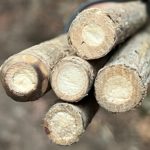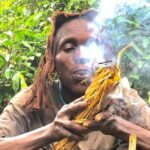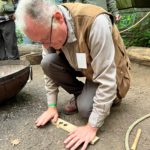Firesaws are only known as a traditional fire-making method on the Pacific Islands. In Australia, these methods were replaced by friction fire hand drills and later, under Western influences, by bow drills. Nevertheless, fire sawing is an interesting technique, which was famously described by Robert Brough Smyth in his book: ‘The Aborigines Of Victoria V1: With Notes Relating To The Habits Of The Natives Of Other Parts Of Australia And Tasmania (1878)’. The whole book can be legally downloaded here.
The following are excerpts of the original text and the two original figures published to benefit the wider bushcraft and survival community. I only added titles and ‘Lessons learned’ to R. Brough Smyth’s text.
Related articles on this website include Friction fire Bow drilling, Friction fire Hand drilling, and Australian friction fire wood species.
Fire saw method 1
‘The inhabitants of the Lower Murray, near Swan Hill, procure fire by a different method. Out of a suitable piece of wood, the Aboriginal cuts a knife – in shape almost like a butcher’s knife – and in another piece, he cuts a long thin slit. In the slit, he places finely powdered dry gum leaves, powdered dry grass, or some other flammable substance.
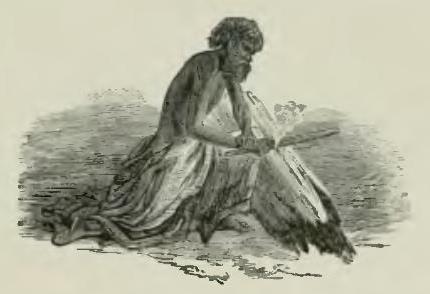
Placing the stick with the longitudinal slit in it in a secure position, he rubs the wooden knife across or at right angles to the slit very rapidly, holding the knife generally with the right hand, and, to give greater energy and steadiness to his movements, keep the right wrist firmly in the left hand.
Instead of preparing a second stick with the longitudinal slit in it, he does not seldom take advantage of the cracks in the trunk of a dry fallen tree. Some dry substance carefully reduced to powder by the hand is put into the cracks, and the wooden knife, used in the same manner as above described, soon produces smoke and fire.’
Practical demonstration of fire sawing
‘The latter is the mode I saw successfully employed at Coranderrk by a native of the Murray. When the Yarra men had got fire by twirling the upright stick, Gulpie said that he knew of a quicker and better method of getting fire. This annoyed some of the old men of the Yarra tribe, who denied that any other means could be employed by an Aboriginal. Knowing well what he proposed to do, I encouraged Gulpie to make an experiment. He cut a wooden knife in a few moments, sat down beside a dry log, and having filled the longitudinal cracks with dry grass, which he had previously well rubbed in his hands, he commenced operations, and in a few seconds sent up a smoke.’
Fire saw method 2
‘In the north-eastern parts of Australia, a very similar method, it is said, is adopted. In the following figure, the man is represented in a sitting posture. Having planted in the ground a strong stick, in which a longitudinal slit has been made, or in which there is a natural slit, and having filled the slit with dry powdered gum leaves or the like, he draws the stick towards him and keeps it firmly in its place by pressing his chest against it. In his hand, he holds the wooden knife, which he rubs rapidly across the stick until he gets fire.
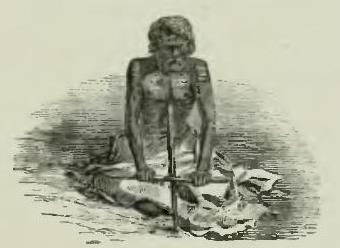
Travelers have informed me that they have seen the wooden knife or wedge employed by some men in the interior exactly in the same way as the Maories use it—that is to say, rubbed rapidly along a groove until the fine charcoal-dust at the extremity is ignited. The Aborigines of the Yarra, and others in Victoria, assert that they have never heard of this plan.’
.
.
Transporting fire with Banksia cones
‘There are probably many other ways of using the firesticks known to the tribes in the interior, but all the evidence yet obtained shows that friction only – and no easier or better method – is resorted to by the Australians on the somewhat rare occasions when they have to practice the art of getting fire. Their habits, in the ordinary life of a tribe, would prevent the necessity of having recourse to the firesticks. Whether encamped or traveling, a tribe is always well provided with fire. The women must carry fire. A stick, a piece of decayed wood, or more often the beautiful seed stem of the Banksia, is lighted at the fire the woman is leaving; and from her bag, which, in damp weather, she would keep filled with dry cones, or from materials collected in the forest, she would easily, during her journey, preserve the fire got at the last encampment.’
Lessons learned from Australian fire saw methods:
- Cutting a traverse slit in a piece of sturdy, dead, and dry piece of wood can replace the hearth board of other friction fire methods.
- A flat piece of dry wood will be carved and moved back and forth for friction generation.
- In fire sawing method 1, the moving hand is supported and steadied by gripping the other hand.
- Dry, crumbled gum leaves or grass will be used for tinder.
- Fire is transported with smoldering Banksia cones.
Further readings about Fire-making on this website:
Creating fire with a magnifying glass
Hadza hand drill friction fire
Bow Drilling – following the method of Mattias Norberg
Giant Fennel stalks for lighting fire
Batwa pygmies traditional fire lighting method
Manketti wood for friction fire lighting
Bushscout UK’s fire bundle basket
Fire lighting with Flint & Steel
Hand drilling in UK as taught by Dave Watson
Bow drill standard procedure by Dave Watson
Bow drilling in Australia by Gordon Dedman
Hand drill friction fire lighting in Australia
Creating fire by hand drill in Namibia
Australian friction fire wood species
.



